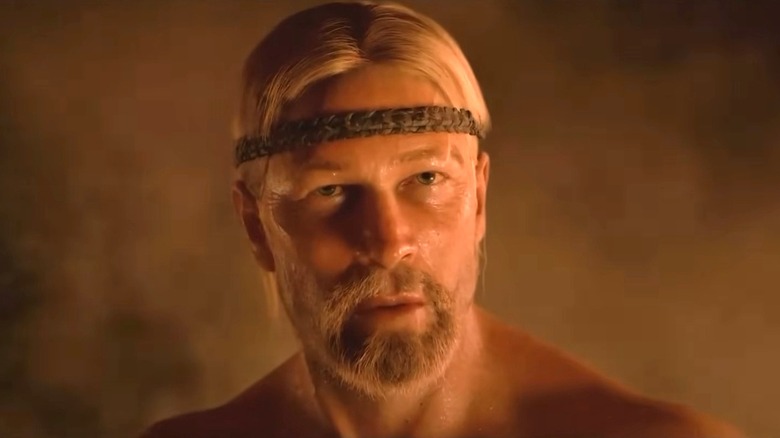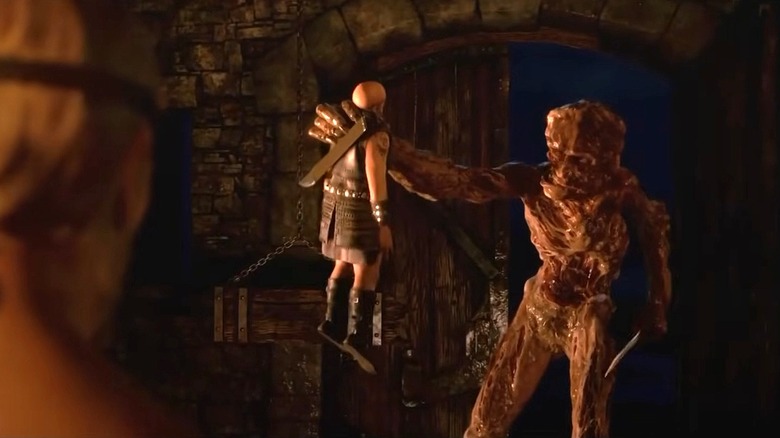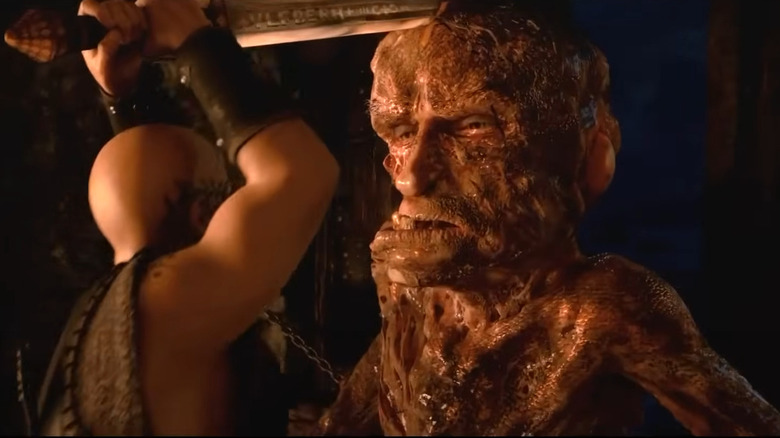How Does Beowulf Kill Grendel & Was It Different In The Angelina Jolie Movie?
"Beowulf" is a classic tale that stretches back to the Middle Ages. The heroic poem is the oldest vernacular epic from Europe and one of the greatest compositions in the history of English literature. The oldest recorded copy is from roughly 1100 years ago, and it wasn't recorded in printed form until 1815.
The story follows three separate duels between the Geatish warrior Beowulf and three antagonists: a demonic monster named Grendel, his ogre-demon mother, and a dragon. The first of these other-worldly creatures battles Beowulf in Heorot, the mead hall of the Danish King Hrothgar, where Grendel has terrorized, killed, and eaten the locals for a dozen years. When Beowulf shows up, he decides to battle Grendel without his weapons or shield as a matter of honor because, obviously, the demon won't have those weapons of civilized warfare, either.
Grendel arrives on the premises and discovers Beowulf has unnatural, God-given strength. The two proceed to duel throughout the building, destroying everything in sight. In J.R.R. Tolkien's translation of the original text (the Oxford professor was a huge fan of the Beowulf story), we get the line, "Great wonder was it then that that house of wine endured their battling, so that it fell not to the ground, fair dwelling upon the earth."
The text shortly after this informs us that Grendel "had laid a spell upon all victorious arms and upon every blade" so that they couldn't harm him. In other words, Beowulf unwittingly gives himself the best chance to beat the monster in weaponless combat. He refuses to let go of Grendel, eventually ripping his entire arm right out of its socket. The demon flees back to his monstrous mother, where he bleeds out, setting the stage for the next part of the story.
A really weird animated adaptation...
Okay, the original Beowulf epic is about as badass as it gets. But how does the latest modern adaptation compare? In 2007, a version of Beowulf was created and released using motion capture technology to tell a real-looking (kind of) animated iteration of the story. Neil Gaiman ("Good Omens," "The Sandman") was attached to the project as a writer, and it was directed by Robert Zemeckis, who had made the animated Christmas classic "The Polar Express" a few years earlier. Unfortunately, the application of mocap and animated tech at this stage of cinematic history didn't go over as well as planned, and the resulting film, simply titled "Beowulf," was tepidly received by many viewers (it still has a miserable 50% Rotten Tomatoes audience score nearly two decades later).
Nevertheless, the adapted version featured big-name actors' voices, including Anthony Hopkins as King Hrothgar and Angelina Jolie as Grendel's Mother. The screaming Grendel was portrayed by Crispin Glover, and he is similarly defeated by a weaponless Beowulf (Ray Winstone) before suffering dismemberment and fleeing to die from blood loss. However, there are several massive changes that happen in the movie version compared to the original text, so much so that two scenes are nearly unrecognizable.
How does the Angelina Jolie animated film compare to the original story?
In the original poem, the Beowulf/Grendel fight is fairly quick and few details are given. This allowed the 2007 version to dive into all sorts of additions and extrapolations, the first of which is Beowulf's garb.
In the movie version, the dude is buck-naked, which is reading into the text a bit (where it just says he lays aside his weapons and armor). This wouldn't be a big deal, but the fact that he's naked means there are multiple moments where the camera is positioned just well enough to block certain areas of Beowulf's body. It's funny for a minute — but awkward for five. It gives the entire view of the fight a stiffer feeling than necessary as it rages around the mead hall.
Grendel is also shown as a tortured, almost pitiable creature, even though he's unilaterally evil in the text. He also has a strange growth in his ear, causing Beowulf to defeat him through repeated blows to the head. These cause Grendel to shrink before he tries to flee. Additionally, Beowulf doesn't hold onto him, but the beast accidentally gets tangled up in a broken chandelier chain, causing the hero to trap him and break only part of his arm off using the door for leverage. All of these are changes from the original source material.
To be fair, the gist of the scene does get the same story across, albeit without Beowulf's superhuman strength. At least he ends up slaying the demon. That said, let's not even go near the adaptation's decision to have him impregnate Grendel's mother and birth the very dragon that he later has to fight. Let's stick with the original version where, you know, he just kills all the monsters.


